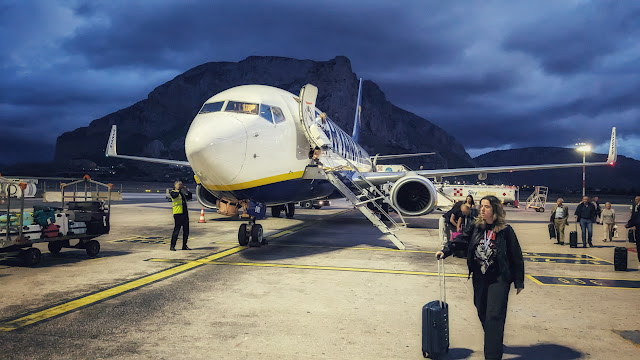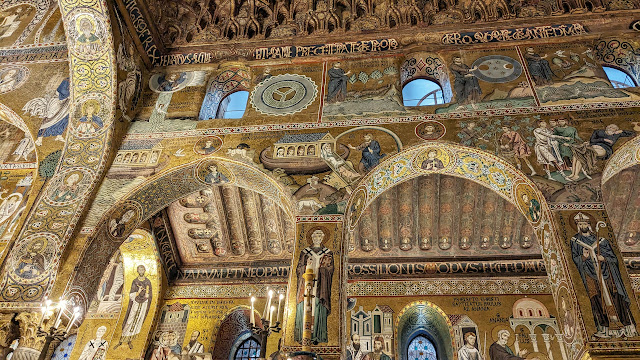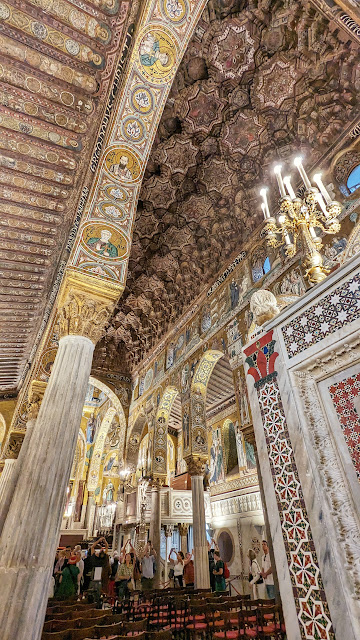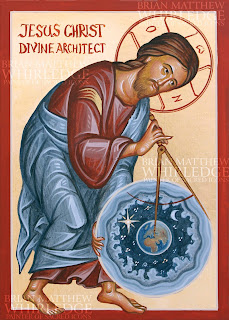Cappella Palatina and Cefalu
We landed in Sicily at early, went through passport control and baggage claim, and were in the car within 17 minutes. It was the fastest time deplaning ever. We exited on a stairway on the tarmac (evidently Ryanair is too cheap to pay to use the jetbridge), but the airport lights dramatically lit up the plane against the dark mountain backdrop.'
Our first time walking through the streets of Palermo reminded me a lot of Greece. The narrow streets are paved in uneven marble. The buildings are quite old and made of stone. Some are still bombed out from the second world war. Balconies overhang the streets and cars squeeze past pedestrians and parked cars. Apartment buildings have a locked iron gate leading to a courtyard filled with plants and scooters. Our tiny elevator reminded us of elevators in Greece, especially it's part-time functionality.
It rains very rarely in Palermo, and I guess we're really lucky to have brought rain from England. Between rainshowers, I walked 15 minutes to Cappella Palatina. In the 11th century, the Norman King Roger II conquered Sicily, liberating it from Arab domination. He built a magnificent palace in the capital Palermo. The Cappella Palatina is the small private chapel within his palace. He hired the best artists from Constantinople to tessarate the mosaics. He also hired local Arab artists to execute all the decoration. This church is incredibly beautiful and perfectly executed. The eclectic styles complement each other to synsethize a perfect harmony.
I was surprised just how Arab the church is. Islam is iconoclastic, so the Arab world developed beautiful non-figurative art based on geometric patterns. There is also an intricate inlay tradition displayed in the church decoration. The nave ceiling is incredibly complex, made up of three-dimensional geometric forms, many of which seem to drip down like stalactites in a cave. The aisle ceilings were richly painted with icons of saints and non-figurative decoration. The script between the ceilings and mosaics is so delightful; something I will certainly reference in my icons.
The iconographic program of the dome eastern wall are fairly standard: Christ Pantocrator (the Almighty) reigns over his Church the basilica apse. Below him is his Mother (clearly a Renaissance restoration). Unusually, the life of Christ is only in the southern transept (or crossing). There is no Passion and Resurrection narrative. My guess would be that the north wall contained it originally, and was replaced with a landscape during a restoration. I overheard a guide say this chapel never contained the Passion cycle; his explanation was that the church was built as a monument of the victory over the Arabs, and didn't want to show Christ suffering. The upper nave walls illustrate Genesis in great detail. The lower nave walls depict the lives of Saints Peter and Paul, the patrons of this chapel. The west wall shows Christ enthroned, flanked by these Chief Apostles.
I was able to spend a little over two hours in this marvelous space. I took copious detailed photographs on my DSLR to reference in my work. I spent most of the time sketching. Sketching is my way of really taking in a place, slowing down to really focus on details and to marinate in the space. It's easy to breeze through, snap a few photos, and move along to the next thing, as I saw hundreds of tourists file in and out during my time. Sketching forces me to slow down and really observe. Drawing is more about seeing than making marks on a page. I'm looking forward to many hours of sketching on location over the next three weeks in Italy, Turkey, and Greece.
The next must-see church on our itinerary was Cefalu. We took the train from Palermo to see the lovely mosaics of the Cefalu Duomo, or cathedral. The apsidal mosaics are quite similar in composition to the Cappella Palatina but on a much grander scale. We rushed through the rain from the train station to the cathedral. We shook off our umbrellas in the exonarthex (porch), entered the doors, and my heart sank. The mosaics are undergoing restoration, and will not be visible until next year. This is a huge disappointment! I better take this lemon and make lemonade (or limoncello). Part of the experience is to get a sense of the place, the scale, and the environment. I couldn't see the actual mosaics, but I did take some time to make a sketch of the printed copy.
After some consolation-prizegelato, we took a rainy train back to Palermo, and ate dinner again at our favorite spot, Ciurma, trying different delicious seafood dishes. George wanted more calamari, Bekah ordered pasta with mussels, and I ate a pistachio pesto pasta with shrimp. Tomorrow, we're looking forward to the little jewel-box church of Martorana in Palermo and the magnficent Monreale Cathedral.



















Comments
Post a Comment